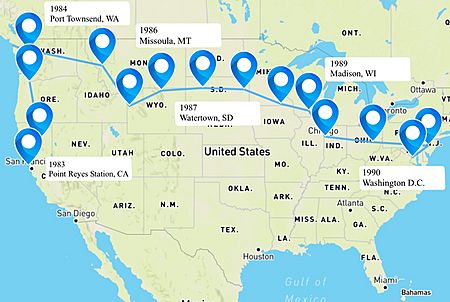John Francis (environmentalist) facts for kids
Quick facts for kids
John Francis
|
|
|---|---|
| Born | 1946 (age 78–79) Philadelphia, Pennsylvania, U.S.
|
| Education | Southern Oregon University (BS) University of Montana (MA) University of Wisconsin–Madison (PhD, 1991) |
| Occupation | Environmentalist |
| Known for | Not riding in motorized vehicles (1972-1994)
Vow of silence (1973-1990) United Nations Environmental Program Goodwill ambassador (1991) Wrote Planetwalker: How to Change Your World One Step at a Time |
John H. Francis III (born 1946) is an American environmentalist known as The Planetwalker. He is famous for his dedication to protecting the Earth. For 22 years, he traveled without using cars or buses. For 17 of those years, he also chose not to speak.
His incredible journey began after he saw the damage from a major oil spill in 1971. This event inspired him to make big changes in his life. During his years of walking and silence, he earned three college degrees, including a PhD. He walked across the United States and even traveled to South America. He later wrote a book about his experiences called Planetwalker.
Contents
A Life-Changing Decision
John Francis was born in Philadelphia, Pennsylvania. As a young man, he moved to Marin County, California.
In 1971, two large oil tankers crashed in San Francisco Bay. This caused a huge oil spill that harmed the environment and local wildlife. Seeing this devastation deeply affected Francis. He decided he no longer wanted to be part of the problem. A year later, he made a promise to stop riding in motorized vehicles. This promise lasted for 22 years.
As Francis walked everywhere, he often got into arguments with people about his choice. To better understand others and himself, he made another big decision on his birthday in 1973. He decided to be silent for one day as a "gift" to his community. He found that listening instead of arguing was very powerful. He continued his silence for 17 years.
During this time, he communicated using hand gestures and by writing notes. He also played the banjo to express himself. He ended his vow of silence on Earth Day in 1990.
Learning on the Move
Even while silent and constantly walking, John Francis was determined to continue his education. He believed that learning was a key part of his journey.
First, he walked to Ashland, Oregon, to attend Southern Oregon University. He earned a bachelor's degree there. He then walked to Montana to get his master's degree in environmental studies from the University of Montana. He often audited classes because he had little money. Professors saw his dedication and helped him get credit for his work once funds were available.
For his final degree, Francis walked to Wisconsin. He earned a PhD in Land Resources from the University of Wisconsin–Madison in 1991. His research focused on the effects of oil spills. This became very important when the Exxon Valdez disaster happened in Alaska. His knowledge was needed to help with the cleanup efforts.
The Planetwalker's Journey
In 1983, Francis began his longest journey: a walk across the entire United States. He started a non-profit group called Planetwalk to promote environmental awareness through his walk. His goal was to inspire people to think about how their actions affect the planet.
His walk was not easy. He faced harsh weather, from hot deserts to freezing winters. He had to find food and water and deal with loneliness. Along the way, he met many different people. Some were kind and supportive, while others did not understand his mission. He learned to rely on the kindness of strangers and the strength of his own spirit.
He walked through mountains, forests, and plains. He followed rivers and train tracks, seeing the country in a way few people ever do. His journey was a pilgrimage—a special trip with a deep personal meaning. It was about connecting with the Earth and with other people on a fundamental level.
After 17 years of silence, he decided to speak again on Earth Day in 1990. He wanted to use his voice to speak for the environment. His long walk across the country showed that one person's actions can make a big difference.
Working for the Planet
After earning his PhD, Francis used his knowledge to help protect the environment in new ways. He went to Washington, D.C. to work with the United States Coast Guard. He helped write new rules to prevent and manage oil spills, based on lessons from the Exxon Valdez disaster. For his work, he received a special award for public service.
In 1991, the United Nations Environment Programme named him a Goodwill ambassador. This role allowed him to share his message about environmental care with people all over the world.
In 1994, after 22 years, Francis decided to start using motorized transportation again. He realized he could be more effective in his work if he could travel faster and farther. He boarded a bus at the border of Venezuela and Brazil, ending his long vow.
Francis continues to work as an environmentalist and educator. He founded the organization Planetwalk to support environmental education. He has written several books, including Planetwalker: 17 Years of Silence, 22 Years of Walking and a children's book called Human Kindness. He has also worked as a professor and continues to inspire people to take their own steps to change the world.


